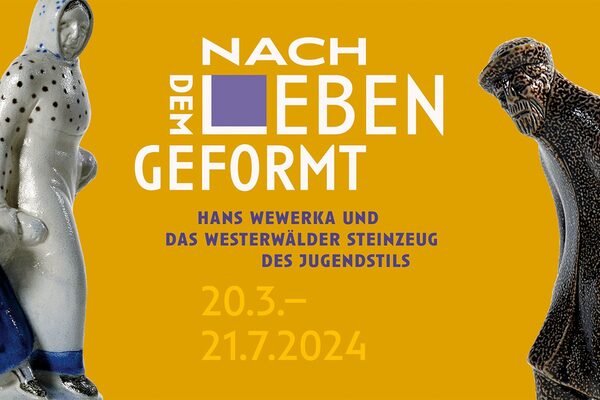Sculpted from life. Hans Wewerka and the Westerwald stoneware of Art Nouveau
From March 20 to July 21, 2024, the sam - Stadtmuseum am Markt hosted a special exhibition on Hans Wewerka.
Sculpted from life. Hans Wewerka and the Westerwald stoneware of Art Nouveau
The special exhibition at sam - Stadtmuseum am Markt was based on the traveling exhibition "Hans Wewerka. Outside" - a joint project of the Forum Gestaltung e.V./ Wewerka Archive in Magdeburg and the Keramikmuseum Westerwald Höhr-Grenzhausen in cooperation with the Ernst Barlach Foundation in Güstrow. The Stadtmuseum Wiesbaden expanded the original presentation with in-depth insights into the artist Hans Wewerka and his work.
The ceramist and sculptor Hans Wewerka (1888-1915) formed the centerpiece of the exhibition. He grew up in Höhr-Grenzhausen, the ceramics center of the Westerwald, where he attended the Royal Ceramics College. One of his first teachers here was Ernst Barlach. Wewerka received further training at the Düsseldorf School of Arts and Crafts. His formative teachers there were the sculptor Rudolf Bosselt and the graphic artist Fritz Helmuth Ehmcke. Wewerka followed the former to the Magdeburg School of Arts and Crafts in 1911. There he eventually became a teacher himself in the sculptors and modelers class, which he taught together with Professor Carl Wegener. Hans Wewerka died at the age of 27 in 1915 in a field hospital near the French city of Arras.
The traveling exhibition was the first to be dedicated to this artist, whose limited oeuvre is hardly known to the public today. Wewerka used his sensitive powers of observation to find inspiration for his figurative depictions of streets and market squares. His sources of inspiration were the rural Westerwald, which was characterized by poverty around 1900, and bourgeois life in Düsseldorf. The life-like figures also gave a new direction to Westerwald stoneware and can be classified stylistically between Art Nouveau and Expressionism.
At the last stop of the traveling exhibition in Wiesbaden, all of the artist's 45 known figures were on display. They were juxtaposed with originals by his role models: the sculptors Ernst Barlach, Rudolf Bosselt and the Dutchman Joseph Mendes da Costa. A selection of Westerwald stoneware from the Art Nouveau period rounded off the exhibition and located it in Wiesbaden. Since 1806, the Westerwald, with its valuable clay deposits and centuries-old tradition of salt-glazed stoneware, belonged to the Duchy of Nassau. The Nassau Antiquities Collection therefore also includes a significant collection of Westerwald stoneware.
Kaspar Kögler. In a small circle
sam - City museum on the market
sam - Stadtmuseum am MarktStiftung Stadtmuseum Wiesbaden
Address
65183 Wiesbaden
Arrival
Telephone
Opening hours
Tue to Sun 11-17 h
Thu 11-20 o'clock
Administration
Wiesbaden City Museum Foundation
Bierstadter Str. 1
65189 Wiesbaden
